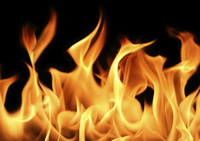Quest for fire
Archaeology professor to research early fire-building skills

One day, tens of thousands of years ago, in the cold and snow of Ice Age Europe, the last Neanderthal died. Exactly why this heavy-browed species disappeared from the Earth after perhaps 200 millennia of existence and why the extinction roughly coincided with the arrival in Europe of modern humans (aka Homo sapiens) migrating from Africa and the Middle East remains unresolved. Paul Goldberg, a College of Arts and Sciences archaeology professor, thinks fire could be a key to solving the mystery.
Earlier this year his theory gained the backing of the National Science Foundation, which awarded Goldberg and an international interdisciplinary team of researchers a two-year $207,000 grant to investigate the technology and behaviors associated with fires ignited in the Paleolithic era. This includes the period, roughly 30,000 to 40,000 years ago, when Neanderthals drop out of the fossil record.
The scholarly debate about what happened way back then pits the theory that crafty modern humans out-innovated Neanderthals and obliterated them as they moved into Europe against the theory that Neanderthals were smart enough to learn from, and coexist with, their modern human neighbors for many years and gradually disappeared through interbreeding with the new arrivals. Goldberg isn’t taking sides, just hoping, he says, “to get some data upon which to refine these interpretations and hypotheses.”
“The development and use of fire is a real fundamental part of human evolution,” Goldberg explains. “The idea is to look at Neanderthal pyrotechnology and behavior and compare it to the fires supposedly made by anatomically modern humans. Are there really differences?”
Previous archaeological investigations of fire tended to use data gathered from bulk sediment samples, determining the presence or lack of human-made fire over the course of centuries. But Goldberg and his team have taken intact samples of individual Stone Age fireplaces from caves in Israel and southwestern France, some of which may have been made by Neanderthals and others by modern humans, allowing the researchers to see what Goldberg terms “little snapshots” of how the people who made the fire lived.
“Our results will, we hope, provide fundamental keys to understanding behavioral differences between Neanderthals and modern humans,” says Francesco Berna, a CAS research associate in archaeology, who is a member of Goldberg’s research team and has a doctorate in soil chemistry.
Goldberg, whose background is geology, takes the samples, which are blocks of earth ranging from the size of a fist to about as big as a cinderblock, dries them, and then encases them in a polyester resin that hardens them like rocks. These are then sliced and sent off to a commercial lab to be ground into extremely thin slide films, usually less than one-thirtieth of a millimeter thick.
He plans to look at about 130 of these slides under a petrographic microscope, which uses polarized light to examine the minerals embedded within the clay. The slides will then be shipped to the rest of the team, which in addition to Berna includes a Spanish expert in plant cells, a German coal petrologist, and another German who uses scanning electron microscopy to determine a soil sample’s elemental makeup. They’ll be using some of the most cutting-edge science to analyze the details of one of humankind’s earliest technological breakthroughs, hoping the clues of minerals, bones, ash, and plant remains will help them find out such things as what the fire makers used for fuel, how hot the fire got, how those who made the fire were able to sustain it, and what the fire was used for.
“Did they burn ground vegetation or wood they’d gathered and stored? Did they dig a fire pit? What did they do with the ashes?” Goldberg asks rhetorically. “All these things represent behavioral choices.”
Goldberg stresses that the aim of this current project is not to solve the debate about coexistence between Neanderthals and Homo sapiens, but to establish how well his team’s methods of analysis work to reveal the details of fire making in different periods of human evolution. “So assuming these techniques work, we’d want to expand our horizons and apply them to samples from many more places,” and more eras in prehistoric time, he explains. “You can’t determine the rules of the game just from these few sites.”